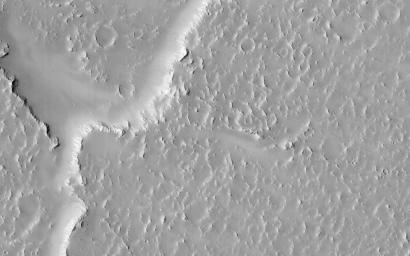
|
Overlapping Lobate Lava Flows in Daedalia Planum
- Click the image above for a larger view
- Full-Res JPEG (2880 x 1800) (515.1 kB)
- Full-Res TIFF (2880 x 1800) (5.2 MB)
Caption:

Map Projected Browse Image
Click on the image for larger version
Lava flows south of Arsia Mons in Daedalia Planum transition from younger flows with elongated, sinuous morphologies to the northeast, to older, broader lobes and sheet flows to the southwest. (The time scale we're talking about is approximately 100 million to 1 billion years.) At the southern margin of the Tharsis region, older, probably 3-billion year old volcanic plains have been identified where Tharsis flows contact the ancient highlands.
The high-resolution of HiRISE images allows for reconstruction of complex volcanic surfaces, including delineation of individual flow lobes and superposition relationships within a flow field. This image shows a contact between two of the younger, elongate flows to the northeast. Populations of small, superposed impact craters can be used to derive relative and absolute age constraints for individual flows and flow sequences.
Background Info:
HiRISE is one of six instruments on NASA's Mars Reconnaissance Orbiter. The University of Arizona, Tucson, operates HiRISE, which was built by Ball Aerospace & Technologies Corp., Boulder, Colorado. NASA's Jet Propulsion Laboratory, a division of the California Institute of Technology in Pasadena, manages the Mars Reconnaissance Orbiter Project for NASA's Science Mission Directorate, Washington.
Cataloging Keywords:
| Name | Value | Additional Values |
|---|---|---|
| Target | Mars | |
| System | ||
| Target Type | Planet | |
| Mission | Mars Reconnaissance Orbiter (MRO) | |
| Instrument Host | Mars Reconnaissance Orbiter | |
| Host Type | Orbiter | |
| Instrument | High Resolution Imaging Science Experiment (HiRISE) | |
| Detector | ||
| Extra Keywords | Crater, Grayscale, Impact, Map, Mountain, Volcano | |
| Acquisition Date | ||
| Release Date | 2014-09-10 | |
| Date in Caption | ||
| Image Credit | NASA/JPL-Caltech/Univ. of Arizona | |
| Source | photojournal.jpl.nasa.gov/catalog/PIA18807 | |
| Identifier | PIA18807 | |
